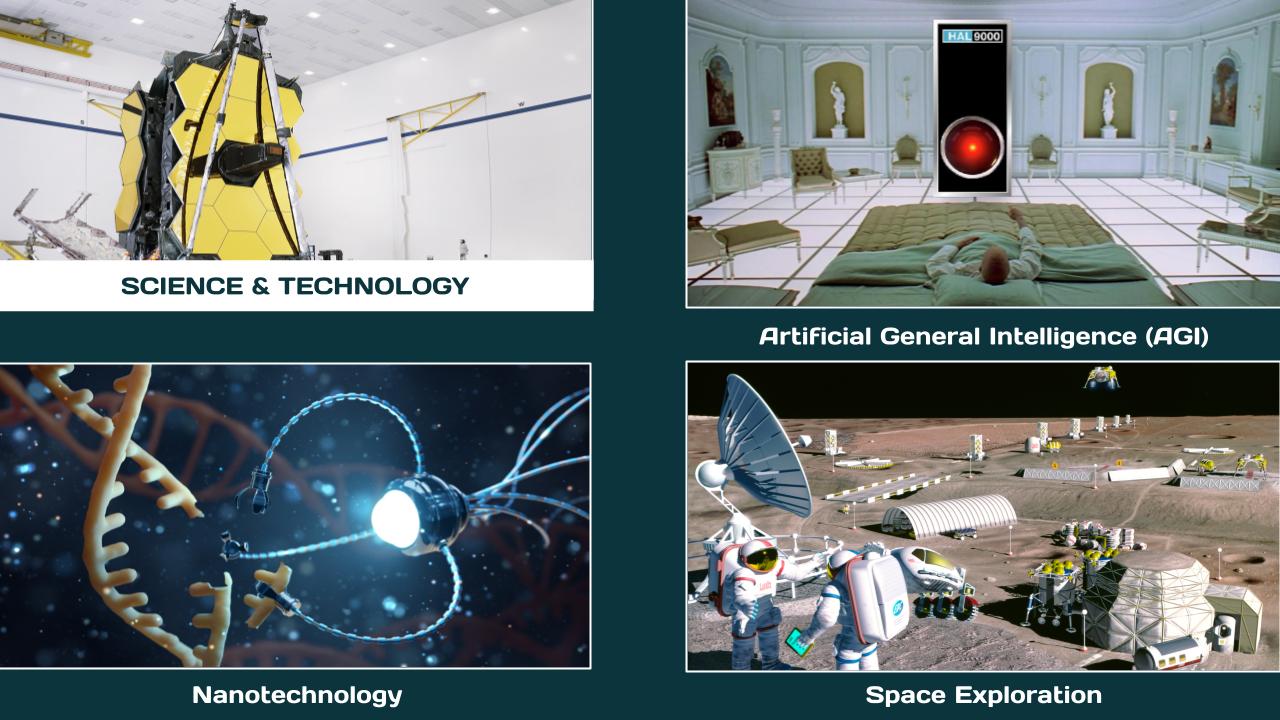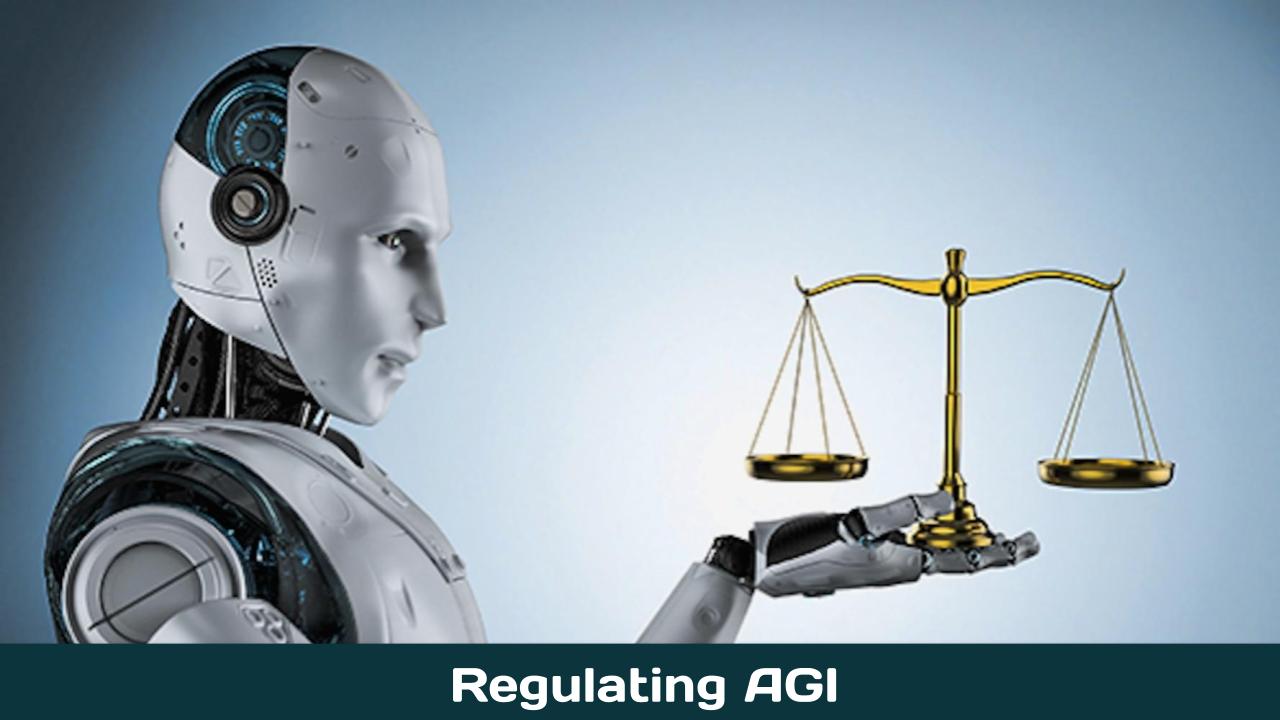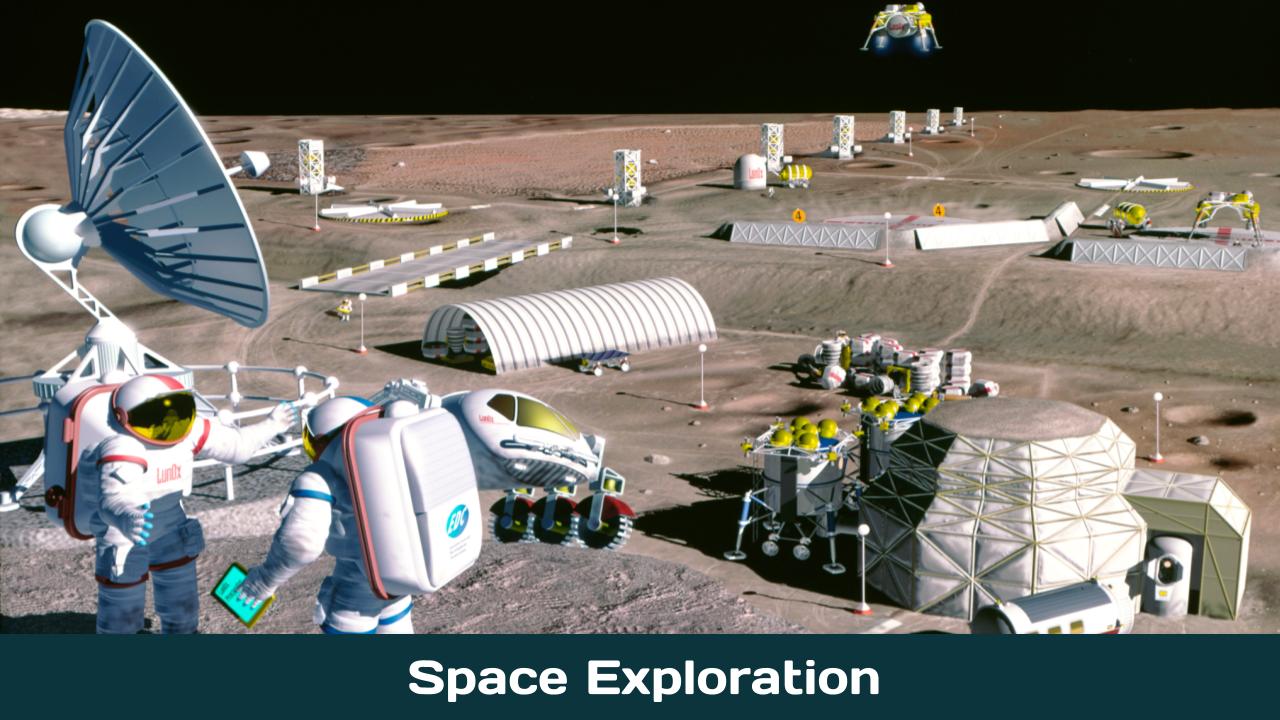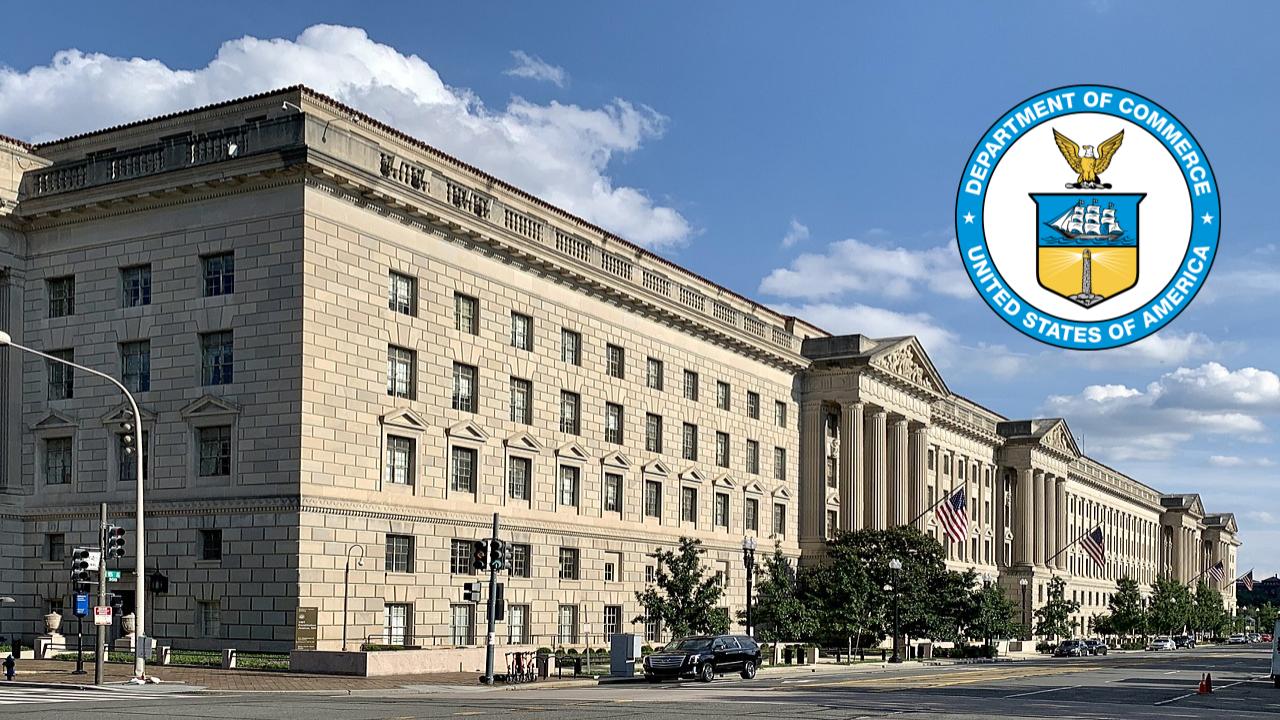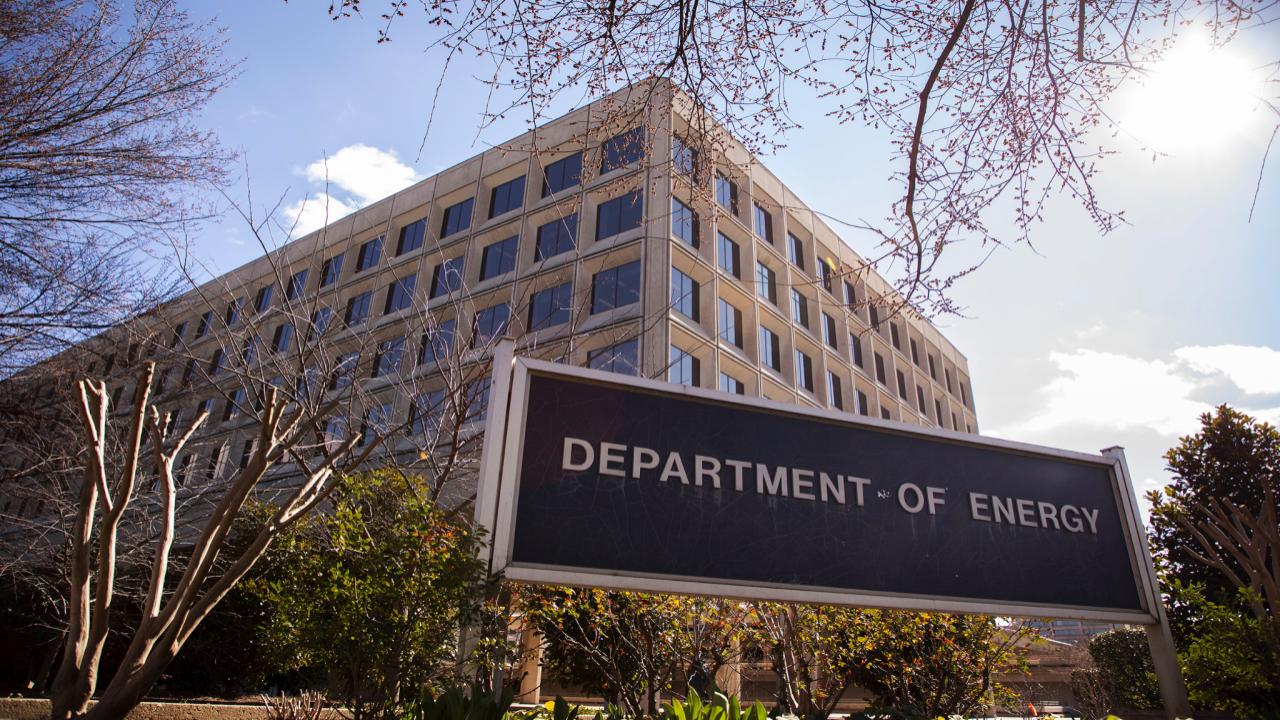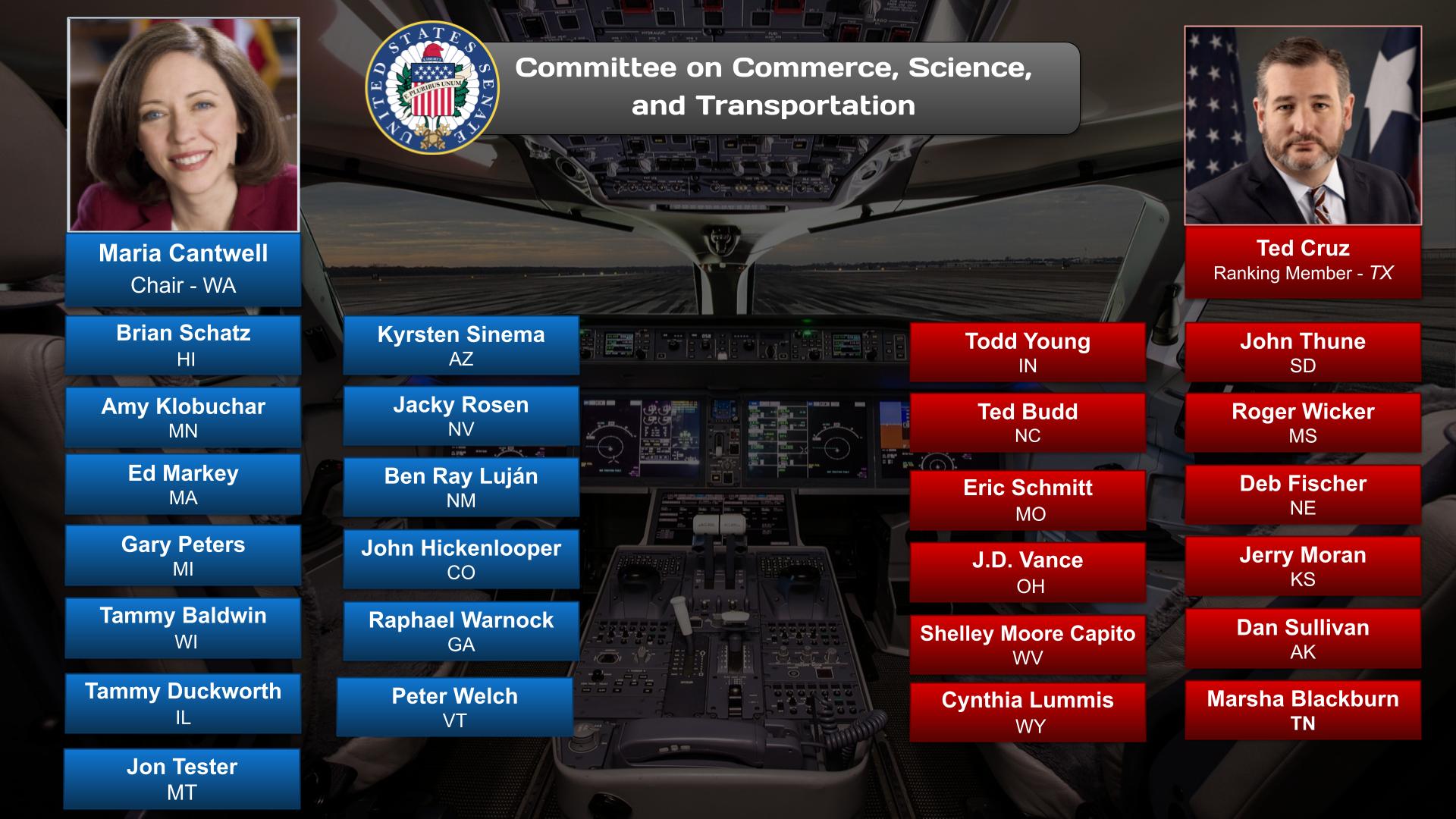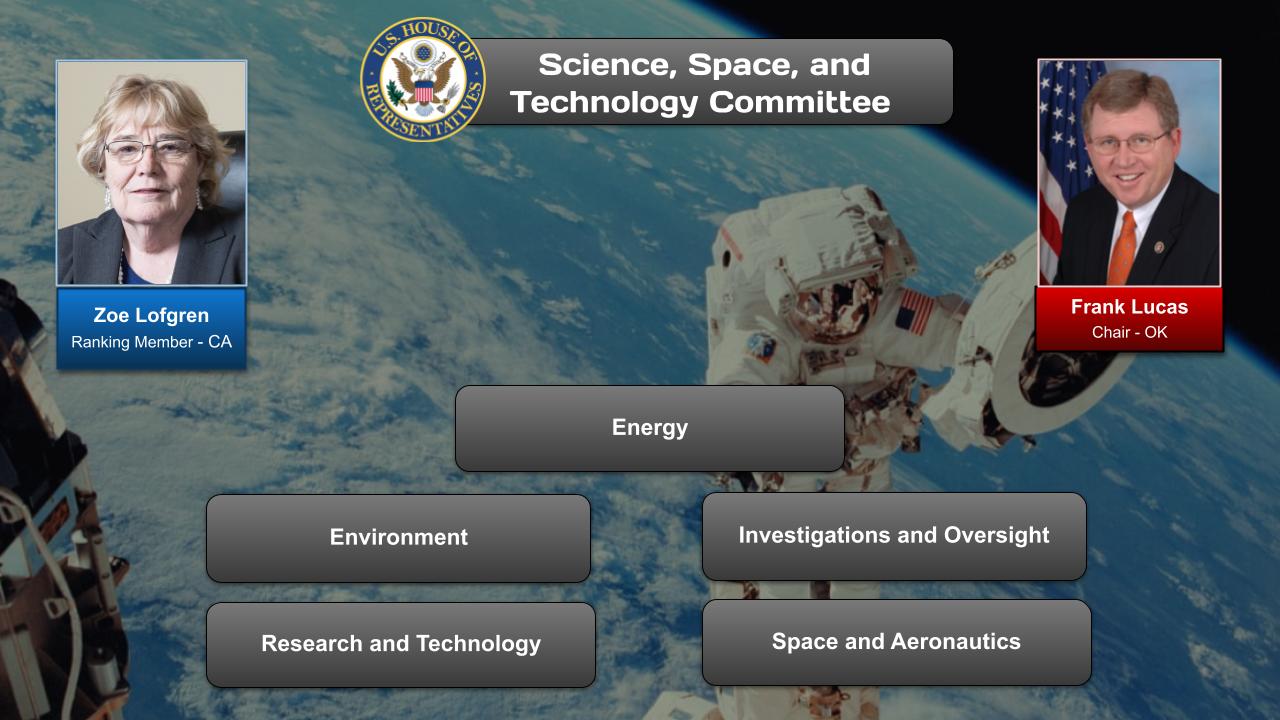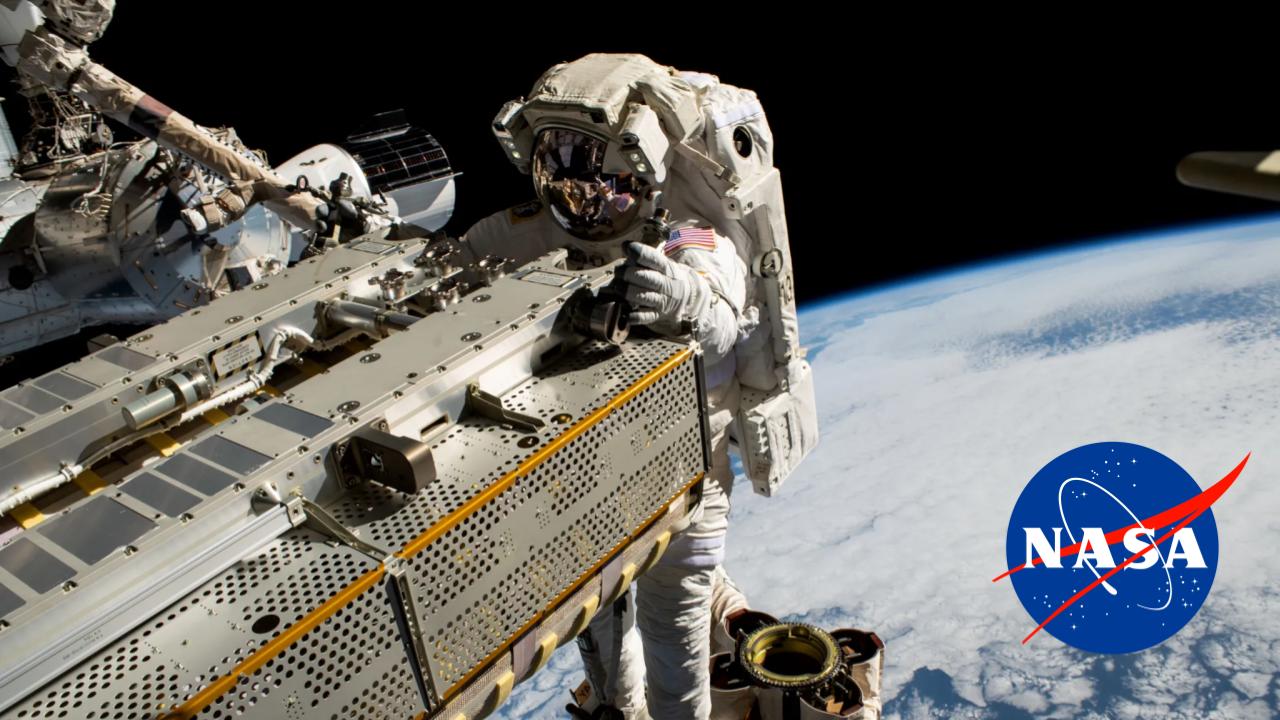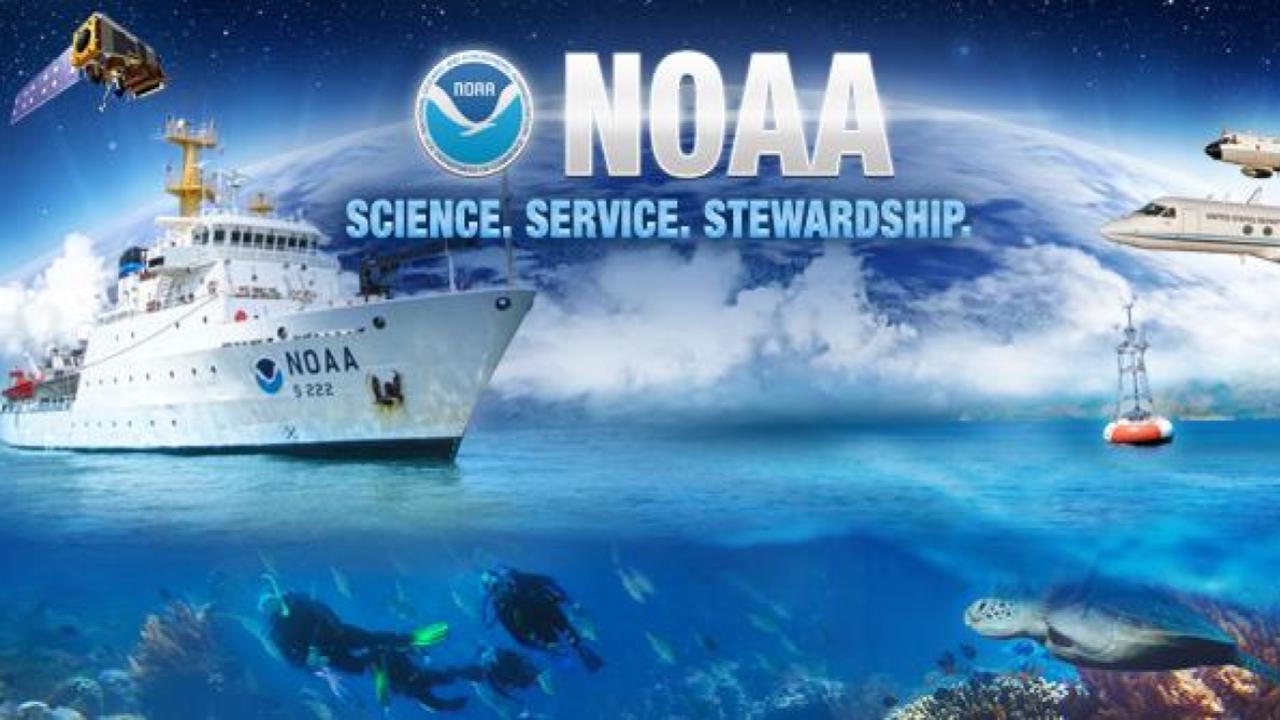Summary
There are many issues related to Science & Technology that Congress is looking to address with legislation.
We have identified three issues for particular focus: Nanotechnology, Artificial General Intelligence (AGI), Space Exploration. This post summarizes the key challenges and solutions around Science & Technology and the ways Congress and the government are addressing them. Go to the posts on each issue to learn more about each issue and how Congress is addressing the problems.
In the Discussion section of this post, you can ask our curators questions, make suggestions, and discuss other issues related to Science & Technology not being addressed in the three focused issues.
CNET: – 28/12/2023 (03:03)
We run down the top tech trends to watch in 2024: quantum computers, electric vehicles, and brain-computer interfaces.
OnAir Post: Science & Technology
News
PBS NewsHour – February 9, 2024 (06:39)
A long legal battle ended Thursday when a jury found that two conservative writers defamed the prominent climate scientist Michael Mann. William Brangham looks at what this verdict means and speaks with another renowned scientist who’s also endured this kind of vitriol, Dr. Peter Hotez.
Today, the Biden-Harris Administration announced that the U.S. Department of Commerce and GlobalFoundries (GF) have signed a non-binding preliminary memorandum of terms (PMT) to provide approximately $1.5 billion in direct funding under the CHIPS and Science Act to strengthen U.S. domestic supply chain resilience, bolster U.S. competitiveness in current-generation and mature-node (C&M) semiconductor production, and support economic and national security capabilities. The proposed funding would support a new state-of-the-art facility, significant capacity expansion, and the modernization of GF’s U.S. manufacturing sites in New York and Vermont, which produce essential automotive, communications, and defense semiconductor technologies.
President Biden signed the bipartisan CHIPS and Science Act to strengthen U.S. supply chains, create good-paying jobs, and advance U.S. economic and national security. Today’s announcement is the third PMT announcement the Department of Commerce has made under the CHIPS and Science Act.
GF chips are fundamental to everyday applications that impact all Americans, from blind spot detection and collision warnings in cars, to smartphones and electric vehicles that last longer between charges, to secure and reliable Wi-Fi and cellular connections. Currently, there are only four companies outside of China that provide current and mature foundry capabilities at the scale of GF – and GF is the only one of those companies that is headquartered in the United States. Shortages of some of these semiconductors caused major disruptions during the COVID-19 pandemic, resulting in a particularly acute impact on the availability and price of a broad range of goods for Americans, as well as the shutdown of automobile manufacturing sites. Part of the proposed funding is expected to support expanding the facility that houses a dedicated capacity corridor for General Motors, with whom GF entered into a strategic long-term supply agreement last year.
“Semiconductors are the brain of modern technology. While they are no larger than a fingernail and no thicker than a piece of paper, they are essential to every electronic device that we currently use – from computers and televisions to cars and washing machines. Thanks to our Administration’s CHIPS and Science Act, we are announcing the Department of Commerce’s preliminary agreement with GlobalFoundries, which will award approximately $1.5 billion to expand domestic production of semiconductors, strengthen U.S. supply chains, and create thousands of good paying jobs right here in America,” said Vice President Kamala Harris. “President Biden and I continue to be fully committed to growing our economy and creating opportunity in every part of America. Today’s announcement is another way in which we are delivering on that commitment in New York, Vermont, and communities throughout the country.”
“Semiconductors are in everything from our cellphones, to refrigerators, to cars, and our most advanced weapons systems, and access to them carries important economic and national security implications. It was the shortages of semiconductors during the COVID-19 pandemic that raised prices for consumers and led to the shutdown of automobile manufacturing sites across the country,” said Secretary of Commerce Gina Raimondo. “Thanks to President Biden’s CHIPS and Science Act, we’re working to onshore these critical technologies in order to bolster the supply of domestic chips that are essential to manufacturing cars, electronics, and national defense systems in New York, Vermont, and states across the country.”
“The CHIPS and Science Act set out to make the United States a leader in semiconductor R&D and manufacturing, and with this proposed CHIPS funding, GlobalFoundries could help realize this vision by modernizing and building new chip fabrication facilities to increase its capacity to make current-generation and mature-node chips in the United States while creating thousands of good jobs in New York and Vermont,” said Under Secretary of Commerce for Standards and Technology and NIST Director Laurie E. Locascio. “By investing in domestic manufacturing capabilities, CHIPS for America is helping secure a stable domestic supply of chips that are found in everything from home electronics to advanced aerospace systems.”
“GF is proud to announce this proposed funding from the Department of Commerce and appreciates the collaboration of the CHIPS Office throughout this process. These proposed investments, along with the investment tax credit (ITC) for semiconductor manufacturing, are central to the next chapter of the GlobalFoundries story and our industry. They would also play an important role in making the U.S. semiconductor ecosystem more globally competitive and resilient,” said Dr. Thomas Caulfield, president and CEO of GF. “With new onshore capacity and technology on the horizon, as an industry we now need to turn our attention to increasing the demand for U.S.-made chips, and to growing our talented U.S. semiconductor workforce.”
The proposed expansion of GF is expected to help advance U.S. economic and national security by increasing capacity, strengthening supply chain resilience, and onshoring technologies in the U.S. for the first time that are important to our defense and intelligence communities. With multiple facilities that are designated as Trusted Foundries by the Department of Defense, GF has a long history of supporting the U.S. military and this proposed funding is expected to strengthen those ties. The Department of Defense relies on GF chips for national defense uses including satellite and space communications. GF chips also support broader U.S. technological leadership and discovery, such as the James Webb Telescope and the International Space Station.
The approximately $1.5 billion in proposed CHIPS funding would be split across three projects:
- Malta, New York – New State-of-the-Art 300 mm Fab: The construction of a new, large-scale 300 mm fabrication facility that is expected to produce high value technologies not currently available in the U.S. The new facility is intended to leverage existing infrastructure to expedite the path from construction to production.
- Malta, New York – Capacity Expansion for Automotive: The proposed expansion of the existing Malta, New York fabrication facility, which includes a strategic agreement with General Motors, to secure a dedicated supply of essential semiconductor technologies. This project would also support America’s economic and national security by expanding domestic capacity for semiconductors that are used in the U.S. critical infrastructure base. This expansion, combined with the new 300 mm fabrication facility, is expected to triple the existing capacity of the Malta campus over the next 10+ years. These two projects are expected to increase wafer production to 1 million per year once all phases are complete.
- Burlington, Vermont – Fab Revitalization: The revitalization of an existing fabrication facility in Burlington, Vermont, to commercialize new 200 mm technologies, creating the first U.S. facility capable of high-volume manufacturing of next-generation Gallium Nitride on Silicon for use in electric vehicles, power grid, 5G and 6G smartphones, and other critical technologies. The site will apply industry-leading sustainability practices, including the use of 100% carbon-neutral energy and the development of an onsite solar system to supply up to 9% of the site’s annual energy.
The proposed projects would create approximately 1,500 manufacturing jobs and approximately 9,000 construction jobs over the next 10 years. The PMT also proposes approximately $10 million in dedicated workforce development funding for GF to work with local workforce, education, training, and community-based organizations to provide GF with the facilities and construction talent they need now and in the future. GF also continues to build upon its GF Maintenance Technician Apprenticeship Program, which is the first U.S. registered semiconductor apprenticeship program and graduated its first apprentices in 2022. In recognizing the critical importance of child care for its operations, the company will not only continue to provide its $1,000 annual subsidy and child care support concierge service to its growing facility workforce but also extend these benefits to its construction workers. The company will be operating under an existing Project Labor Agreement (PLA) in New York and is in the process of establishing a PLA in Vermont for the purposes of this project.
In addition to potential direct funding, the CHIPS Program Office would make approximately $1.6 billion in loans available to GF under the PMT. The total potential public and private investment for the combined projects would be approximately $12.5 billion.
As explained in the Department’s first Notice of Funding Opportunity, the Department may offer applicants a PMT on a non-binding basis after satisfactory completion of the merit review of a full application. The PMT outlines key terms for a CHIPS incentives award, including the amount and form of the award. After the PMT is signed, the Department begins a comprehensive due diligence process on the proposed project and other information contained in the application. After satisfactory completion of the due diligence phase, the Department may enter into final award documents with the applicant. Terms of the final award documents are subject to negotiations with the applicant and may differ from the terms of the PMT.
About CHIPS for America
The Department has received more than 600 statements of interest, more than 160 pre-applications and full applications for NOFO 1, and more than 160 small supplier concept plans for NOFO 2. The Department is continuing to conduct rigorous evaluation of applications to determine which projects will advance U.S. national and economic security, attract more private capital, and deliver other economic benefits to the country. The announcement with GlobalFoundries is the third PMT announcement the Department of Commerce has made under the CHIPS and Science Act, with additional PMT announcements expected to follow throughout 2024.
CHIPS for America is part of President Biden’s economic plan to invest in America, stimulate private sector investment, create good-paying jobs, make more in the United States, and revitalize communities left behind. CHIPS for America includes the CHIPS Program Office, responsible for manufacturing incentives, and the CHIPS Research and Development Office, responsible for R&D programs, that both sit within the National Institute of Standards and Technology (NIST) at the Department of Commerce. NIST promotes U.S. innovation and industrial competitiveness by advancing measurement science, standards, and technology in ways that enhance economic security and improve our quality of life. NIST is uniquely positioned to successfully administer the CHIPS for America program because of the bureau’s strong relationships with U.S. industries, its deep understanding of the semiconductor ecosystem, and its reputation as fair and trusted. Visit https://www.chips.gov to learn more.
About
Overview
The United States Constitution itself reflects the desire to encourage scientific creativity. It gives the United States Congress the power “to promote the progress of science and useful arts, by securing for limited times to authors and inventors the exclusive right to their respective writings and discoveries.” This clause formed the basis for the U.S. patent and copyright systems, whereby creators of original art and technology would get a government granted monopoly, which after a limited period would become free to all citizens, thereby enriching the public domain. Wikipedia Entry on Science and technology in the US
Artificial Intelligence (AI)
- Ethical and responsible development and use
- Algorithmic bias and fairness
- AI safety and control
- Impact on employment and the economy
Biotechnology and Health
- Gene editing and gene therapy
- Precision medicine and personalized treatments
- Drug discovery and development
- Biosecurity and infectious disease threats
Quantum Computing
- Development of quantum computers and algorithms
- Security and encryption implications
- Applications in materials science, medicine, and finance
Space Exploration
- Human missions to Mars and beyond
- Space telescopes and exoplanet research
- Space resource utilization
- Space debris and sustainability
Materials Science
- Advanced materials for energy, electronics, and healthcare
- Nanomaterials and composites
- Sustainable and biodegradable materials
- 3D printing and additive manufacturing
Cybersecurity and Data Privacy
- Protection against cyber attacks and data breaches
- Data encryption and privacy preservation
- Ethical considerations and government regulation
Energy Security and Power Systems
- Decarbonization of the power grid
- Smart grids and microgrids
- Energy storage and transmission
- Cybersecurity and resilience of energy infrastructure
Food and Agriculture
- Sustainable and resilient food production
- Precision agriculture and data analytics
- Genetically modified crops and food safety
- Climate-resilient crops and livestock
Transportation and Infrastructure
- Electric and autonomous vehicles
- Smart cities and urban planning
- Sustainable transportation systems
- Infrastructure resilience and maintenance
Climate Change and Sustainability
- Emissions reduction and climate adaptation
- Renewable energy and energy efficiency
- Carbon capture and storage
- Sustainable development and biodiversity conservation
Source: Google Search + Gemini & Some onAir curation
Party Positions
Republican Party platform: In 2020, the Republican Party decided not to write a platform for that presidential election cycle, instead simply expressing its support for Donald Trump’s agenda.
- Go here to see a PDF on 2016 Republican Platform.
- Go to this Wikipedia entry to read “Political positions of Donald Trump”.
Democratic Party platform:
- Go here to read the Democratic Party’s plaform on the DNC’s website especially the section on Restoring and strengthening our democracy
- Go to this Wikipedia entry to read the”Political positions of the Democratic Party”
Democratic Party
- Investments in research and development: Supports increased funding for basic and applied scientific research and technological innovation.
- Climate change mitigation: Recognizes the urgency of addressing climate change and supports policies to reduce carbon emissions, promote renewable energy, and invest in climate adaptation measures.
- Healthcare innovation: Prioritizes access to affordable healthcare and supports efforts to develop new medical technologies and treatments.
- Cybersecurity: Emphasizes the importance of protecting national security and critical infrastructure from cyber threats.
- Artificial intelligence regulation: Supports the responsible development and use of AI, with a focus on addressing potential risks and biases.
Republican Party
- Reduced government regulation: Supports minimizing government intervention in the private sector, including in areas of science and technology.
- Energy independence: Prioritizes domestic energy production and emphasizes the role of fossil fuels in the energy mix.
- Healthcare deregulation: Favors reducing government involvement in the healthcare system, supporting the free market as a driver of innovation.
- Cybersecurity defense: Supports strengthening national security through cybersecurity measures, focusing on threat detection and response.
- AI competitiveness: Emphasizes U.S. leadership in AI and supports policies to promote innovation and economic growth in this area.
Key Differences
- Role of government: Democrats generally support a more active government role in supporting scientific research and regulating technology, while Republicans favor a smaller role.
- Climate change: Democrats prioritize addressing climate change, while Republicans have varied views on its severity and appropriate mitigation strategies.
- Healthcare: Democrats prioritize expanding access to affordable healthcare and supporting medical innovation, while Republicans favor market-based approaches.
- Regulation: Democrats support more stringent regulation of emerging technologies like AI, while Republicans favor a lighter regulatory touch.
- International cooperation: Democrats generally support international collaboration in science and technology, while Republicans may be more hesitant.
Source: Google Search + Gemini + onAir Curators
Key Websites
General Science and Technology News
Artificial Intelligence and Machine Learning
Biotechnology and Healthcare
- National Institutes of Health (NIH)
- Centers for Disease Control and Prevention (CDC)
- World Health Organization (WHO)
- GenomeWeb
- FierceBiotech
Climate Change
- NASA Climate
- National Oceanic and Atmospheric Administration (NOAA)
- Intergovernmental Panel on Climate Change (IPCC)
- Climate Central
- Scientific American Climate
Energy
- U.S. Department of Energy
- International Energy Agency (IEA)
- World Energy Council
- Renewable Energy World
- Greentech Media
Environmental Science
- Environmental Protection Agency (EPA)
- World Wildlife Fund (WWF)
- National Audubon Society
- Sierra Club
- The Nature Conservancy
Information Technology
- IEEE Xplore
- Association for Computing Machinery (ACM)
- Computer Science Bibliography (DBLP)
- Ars Technica
- Wired
Space Exploration
Source: Google Search + Gemini + onAir Curators
DEPARTMENT & AGENCIES
Department of Energy (DOE)
Source: onAir post
The United States Department of Energy (DOE) is a cabinet-level department of the United States government concerned with the United States’ policies regarding energy and safety in handling nuclear material. Its responsibilities include the nation’s nuclear weapons program, nuclear reactor production for the United States Navy, energy conservation, energy-related research, radioactive waste disposal, and domestic energy production. It also directs research in genomics; the Human Genome Project originated in a DOE initiative. DOE sponsors more research in the physical sciences than any other U.S. federal agency, the majority of which is conducted through its system of National Laboratories.
The agency is led by the United States Secretary of Energy, and its headquarters are located in Southwest Washington, D.C., on Independence Avenue in the James V. Forrestal Building, named for James Forrestal, as well as in Germantown, Maryland.
Wikipedia Entry Website:energy.gov/
Department of Commerce (DOC)
Source: onAir post
The United States Department of Commerce is an executive department of the U.S. federal government concerned with promoting economic growth.[clarification needed] Among its tasks are gathering economic and demographic data for business and government decision making, and helping to set industrial standards.
This organization’s main purpose is to create jobs, promote economic growth, encourage sustainable development and block harmful trade practices of other nations. The Department of Commerce is headquartered in the Herbert C. Hoover Building in Washington, DC.
Wikipedia Entry Website: commerce.gov
National Aeronautics and Space Administration (NASA)
The National Aeronautics and Space Administration is an independent agency of the U.S. federal government responsible for the civil space program, aeronautics research, and space research. Established in 1958, it succeeded the National Advisory Committee for Aeronautics (NACA) to give the U.S. space development effort a distinctly civilian orientation, emphasizing peaceful applications in space science. It has since led most American space exploration, including Project Mercury, Project Gemini, the 1968–1972 Apollo Moon landing missions, the Skylab space station, and the Space Shuttle. It currently supports the International Space Station and oversees the development of the Orion spacecraft and the Space Launch System for the crewed lunar Artemis program, the Commercial Crew spacecraft, and the planned Lunar Gateway space station.
NASA’s science is focused on better understanding Earth through the Earth Observing System;advancing heliophysics through the efforts of the Science Mission Directorate’s Heliophysics Research Program;exploring bodies throughout the Solar System with advanced robotic spacecraft such as New Horizons and planetary rovers such as Perseverance; and researching astrophysics topics, such as the Big Bang, through the James Webb Space Telescope, the Great Observatories and associated programs. The Launch Services Program oversees launch operations and countdown management for its uncrewed launches.
Wikipedia Entry Website: nasa.gov.
National Science Foundation (NSF)
The National Science Foundation (NSF) is an independent agency of the United States federal government that supports fundamental research and education in all the non-medical fields of science and engineering. Its medical counterpart is the National Institutes of Health. With an annual budget of about $8.3 billion (fiscal year 2020), the NSF funds approximately 25% of all federally supported basic research conducted by the United States’ colleges and universities. In some fields, such as mathematics, computer science, economics, and the social sciences, the NSF is the major source of federal backing.
NSF’s director and deputy director are appointed by the president of the United States and confirmed by the United States Senate, whereas the 24 president-appointed members of the National Science Board (NSB)[5] do not require U.S. Senate confirmation. The director and deputy director are responsible for administration, planning, budgeting and day-to-day operations of the foundation, while the NSB meets six times a year to establish its overall policies. The current NSF director is Sethuraman Panchanathan.
Source: Wikipedia Entry Website: nsf.gov.
National Institutes of Health (NIH)
The National Institutes of Health, commonly referred to as NIH, is the primary agency of the United States government responsible for biomedical and public health research. It was founded in the late 1880s and is now part of the United States Department of Health and Human Services. Many NIH facilities are located in Bethesda, Maryland, and other nearby suburbs of the Washington metropolitan area, with other primary facilities in the Research Triangle Park in North Carolina and smaller satellite facilities located around the United States. The NIH conducts its own scientific research through the NIH Intramural Research Program (IRP) and provides major biomedical research funding to non-NIH research facilities through its Extramural Research Program.
As of 2013, the IRP had 1,200 principal investigators and more than 4,000 postdoctoral fellows in basic, translational, and clinical research, being the largest biomedical research institution in the world, while, as of 2003, the extramural arm provided 28% of biomedical research funding spent annually in the U.S., or about US$26.4 billion.
The NIH comprises 27 separate institutes and centers of different biomedical disciplines and is responsible for many scientific accomplishments, including the discovery of fluoride to prevent tooth decay, the use of lithium to manage bipolar disorder, and the creation of vaccines against hepatitis, Haemophilus influenzae (HIB), and human papillomavirus (HPV).
In 2019, the NIH was ranked number two in the world, behind Harvard University, for biomedical sciences in the Nature Index, which measured the largest contributors to papers published in a subset of leading journals from 2015 to 2018.
Source: Wikipedia Entry Website: nih.gov.
Committees & Caucuses
Senate Committee on Commerce, Science, and Transportation
Source: onAir post
Mission:
Has broad jurisdiction over all matters concerning interstate commerce, science and technology policy, and transportation, the Senate Commerce Committee is one of the largest of the Senate’s standing committees, with 26 members in the 117th Congress.
Wikipedia Entry Website: commerce.senate.gov/members
House counterparts: Energy and Commerce Committee; Science, Space, and Technology Committee; and Transportation and Infrastructure Committee
Democratic Members (Majority):
Maria Cantwell, Washington, Chair
Amy Klobuchar, Minnesota
Richard Blumenthal, Connecticut
Brian Schatz, Hawaii
Ed Markey, Massachusetts
Gary Peters, Michigan
Tammy Baldwin, Wisconsin
Tammy Duckworth, Illinois
Jon Tester, Montana
Kyrsten Sinema, Arizona
Jacky Rosen, Nevada
Ben Ray Luján, New Mexico
John Hickenlooper, Colorado
Raphael Warnock, Georgia
Peter Welch, Vermont
Republican Members (Minority):
Ted Cruz, Texas, Ranking Member
John Thune, South Dakota
Roger Wicker, Mississippi
Deb Fischer, Nebraska
Jerry Moran, Kansas
Dan Sullivan, Alaska
Marsha Blackburn, Tennessee
Todd Young, Indiana
Ted Budd, North Carolina
Eric Schmitt, Missouri
J. D. Vance, Ohio
Shelley Moore Capito, West Virginia
Cynthia Lummis, Wyoming
House Science, Space, and Technology Committee
Mission:
To oversee all non-defense federal scientific research and development. More specifically, the committee has complete jurisdiction over the following federal agencies: NASA, NSF, NIST, and the OSTP. The Committee also has authority over R&D activities at the Department of Energy, the EPA, FAA, NOAA, the DOT, the NWS, the DHS and the U.S. Fire Administration.
Senate Counterpart: Committee on Commerce, Science, and Transportation
Subcommittees:
- Energy
- Environment
- Investigations and Oversight
- Research and Technology
- Space and Aeronautics
Chair: Frank Lucas, Oklahoma (R)
Ranking Member: Zoe Lofgren, California (D)
Majority Staff Director: Janie Thompson
Minority Staff Director: Josh Mathis
Meeting Location: 2321 Rayburn House Office Building, Washington, DC 20515; Phone: 202-225-6371
Wikipedia Entry Government Website:science.house.gov/
Caucuses & Other Committees
- Joint Committee on the Library (Subcommittee on Science)
- Senate Committee on Energy and Natural Resources (Subcommittee on Energy)
Caucuses
House of Representatives
- Congressional Science, Space, and Technology Caucus (CSSTC): Focused on promoting science, technology, engineering, and mathematics (STEM) education and innovation.
- Congressional Robotics Caucus: Advocates for the advancement of robotics technology and its applications across industries.
- Artificial Intelligence Caucus: Promotes responsible development and deployment of artificial intelligence (AI).
- Space Caucus: Focuses on issues related to space exploration, space policy, and aerospace industry.
- Congressional Cyber Caucus: Addresses cybersecurity threats and promotes secure cyberspace.
- Congressional Nanotechnology Caucus: Supports the advancement of nanotechnology research and its applications.
Senate
- Senate Science and Technology Committee: Oversees science and technology policy, research, and development funding.
- Senate Subcommittee on Science, Space, and Competitiveness: Focuses on STEM education, scientific research, and technological innovation.
- Senate Subcommittee on Space, Science, and Competitiveness: Oversees space exploration, NASA funding, and astrophysics research.
- Senate Cybersecurity Caucus: Promotes cybersecurity awareness, research, and policy.
- Senate Artificial Intelligence Caucus: Supports responsible AI development and deployment.
Bipartisan Caucuses
- Congressional Internet Caucus: Addresses issues related to the internet, technology, and cybersecurity.
- Congressional Blockchain Caucus: Promotes the adoption and responsible use of blockchain technology.
- Congressional Caucus on the Future of Work: Focuses on the impact of technology on the workforce and the economy.
More Information
Nonpartisan Organizations
Source: Google Search + Gemini + onAir curation
Science and Technology Policy
- American Association for the Advancement of Science (AAAS)
- Union of Concerned Scientists (UCS)
- Council on Foreign Relations (CFR)
- National Academy of Sciences, Engineering, and Medicine
Science Education
- National Science Teachers Association (NSTA)
- American Association of Physics Teachers (AAPT)
- National Association of Biology Teachers (NABT)
- American Chemical Society (ACS)
Science Communication
- Society for Science & the Public
- American Geophysical Union (AGU)
- American Institute of Physics (AIP)
- Association for the Advancement of Artificial Intelligence (AAAI)
Science and Society
- AAAS Center for Science Diplomacy
- National Organization of Science and Technology Advisors (NOSTRA)
- Federation of American Scientists (FAS)
- American Civil Liberties Union (ACLU)
Energy and Climate Change
- Environmental Defense Fund (EDF)
- Natural Resources Defense Council (NRDC)
- Sierra Club
- American Geophysical Union (AGU)
Health and Medicine
- National Institutes of Health (NIH)
- National Cancer Institute (NCI)
- American Academy of Pediatrics (AAP)
- American Medical Association (AMA)
Partisan Organizations
Source: Google Search + Gemini + onAir curation
Democratic Organizations
- Union of Concerned Scientists (UCS): Advocates for socially responsible use of science and technology, with a focus on climate change, nuclear safety, and responsible innovation.
- Council for Responsible Genetics (CRG): Promotes responsible use of genetic technologies, including the protection of genetic privacy and the prevention of discrimination.
- Public Citizen: Advocates for consumer protection, public health, and environmental safety, including issues related to science and technology.
- Sierra Club: A national environmental organization that addresses issues such as climate change mitigation and adaptation, sustainable energy, and protecting public lands.
- American Civil Liberties Union (ACLU): Defends civil liberties, including the right to privacy and the freedom of speech, which can impact scientific research and innovation.
Republican Organizations
- The Heritage Foundation: A conservative think tank that promotes free-market policies and limited government regulation, including in the areas of science and technology.
- American Enterprise Institute (AEI): A research and educational organization that promotes conservative values, including support for scientific research and innovation.
- Cato Institute: A libertarian think tank that advocates for free-market principles, limited government intervention, and individual liberty, which can impact science and technology policy.
- Competitive Enterprise Institute (CEI): A free-market advocacy organization that challenges government regulations and promotes the benefits of competition, including in the areas of science and technology.
- American Legislative Exchange Council (ALEC): A network of state legislators that promotes conservative legislation, including bills related to science education and environmental regulation.
“Science and technology in the US” (Wiki)
Contents
| This article is part of a series on the |
| Science and technology of the United States of America |
|---|
 |
| Timeline |
| Development |
Science and technology in the United States has a long history, producing many important figures and developments in the field. The United States of America came into being around the Age of Enlightenment (1685 to 1815), an era in Western philosophy in which writers and thinkers, rejecting the perceived superstitions of the past, instead chose to emphasize the intellectual, scientific and cultural life, centered upon the 18th century, in which reason was advocated as the primary source for legitimacy and authority. Enlightenment philosophers envisioned a “republic of science,” where ideas would be exchanged freely and useful knowledge would improve the lot of all citizens.
The United States Constitution itself reflects the desire to encourage scientific creativity. It gives the United States Congress the power “to promote the progress of science and useful arts, by securing for limited times to authors and inventors the exclusive right to their respective writings and discoveries.”[1] This clause formed the basis for the U.S. patent and copyright systems, whereby creators of original art and technology would get a government granted monopoly, which after a limited period would become free to all citizens, thereby enriching the public domain.[2]
Early American science


In the early decades of its history, the United States was relatively isolated from Europe and also rather poor. At this stage, America’s scientific infrastructure was still quite primitive compared to the long-established societies, institutes, and universities in Europe.
Eight of America’s founding fathers were scientists of some repute. Benjamin Franklin conducted a series of experiments that deepened human understanding of electricity. Among other things, he proved what had been suspected but never before shown: that lightning is a form of electricity. Franklin also invented such conveniences as bifocal eyeglasses. Franklin also conceived the mid-room furnace, the “Franklin Stove”. However, Franklin’s design was flawed, in that his furnace vented the smoke from its base: because the furnace lacked a chimney to “draw” fresh air up through the central chamber, the fire would soon go out. It took David R. Rittenhouse, another hero of early Philadelphia, to improve Franklin’s design by adding an L-shaped exhaust pipe that drew air through the furnace and vented its smoke up and along the ceiling, then into an intramural chimney and out of the house.[3]
Thomas Jefferson (1743–1826), was among the most influential leaders in early America; during the American Revolutionary War (1775–83), Jefferson served in the Virginia legislature, the Continental Congress, was governor of Virginia, later serving as U.S. minister to France, U.S. secretary of state, vice president under John Adams (1735–1826), writer of the Declaration of Independence and the third U.S. president. During Jefferson’s two terms in office (1801–1809), the U.S. purchased the Louisiana Territory and Lewis and Clark explored the vast new acquisition.
After leaving office, he retired to his Virginia plantation, Monticello, and helped spearhead the University of Virginia.[4] Jefferson was also a student of agriculture who introduced various types of rice, olive trees, and grasses into the New World. He stressed the scientific aspect of the Lewis and Clark expedition (1804–06),[5] which explored the Pacific Northwest, and detailed, systematic information on the region’s plants and animals was one of that expedition’s legacies.[6]
Like Franklin and Jefferson, most American scientists of the late 18th century were involved in the struggle to win American independence and forge a new nation. These scientists included the astronomer David Rittenhouse, the medical scientist Benjamin Rush, and the natural historian Charles Willson Peale.[6]
During the American Revolution, Rittenhouse helped design the defenses of Philadelphia and built telescopes and navigation instruments for the United States’ military services. After the war, Rittenhouse designed road and canal systems for the state of Pennsylvania. He later returned to studying the stars and planets and gained a worldwide reputation in that field.[6]
As United States Surgeon General, Benjamin Rush saved countless lives of soldiers during the American Revolutionary War by promoting hygiene and public health practices. By introducing new medical treatments, he made the Pennsylvania Hospital in Philadelphia an example of medical enlightenment, and after his military service, Rush established the first free clinic in the United States.[6]
Charles Willson Peale is best remembered as an artist, but he also was a natural historian, inventor, educator, and politician. He created the first major museum in the United States, the Peale Museum in Philadelphia, which housed the young nation’s only collection of North American natural history specimens. Peale excavated the bones of an ancient mastodon near West Point, New York; he spent three months assembling the skeleton, and then displayed it in his museum. The Peale Museum started an American tradition of making the knowledge of science interesting and available to the general public.[6]
Science immigration
American political leaders’ enthusiasm for knowledge also helped ensure a warm welcome for scientists from other countries. A notable early immigrant was the British chemist Joseph Priestley, who was driven from his homeland because of his dissenting politics. Priestley, who migrated to the United States in 1794, was the first of thousands of talented scientists drawn to the United States in search of a free, creative environment.[6]
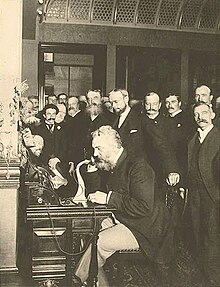
Other scientists had come to the United States to take part in the nation’s rapid growth. Alexander Graham Bell, who arrived from Scotland by way of Canada in 1872, developed and patented the telephone and related inventions. Charles Proteus Steinmetz, who came from Germany in 1889, developed new alternating-current electrical systems at General Electric Company,[6] and Vladimir Zworykin, an immigrant who arrived from Russia to the States in 1919, bringing his knowledge of x-rays and cathode ray tubes and later won his first patent on a television system he invented. The Serbian Nikola Tesla went to the United States in 1884, and would later adapt the principle of the rotating magnetic field in the development of an alternating current induction motor and polyphase system for the generation, transmission, distribution and use of electrical power.[7]

Into the early 1900s, Europe remained the center of science research, notably in England and Germany. From the 1920s onwards, the tensions heralding the onset of World War II spurred sporadic but steady scientific emigration, or “brain drain“, in Europe. Many of these emigrants were Jewish scientists, fearing the repercussions of anti-Semitism, especially in Germany and Italy, and sought sanctuary in the United States.[8] One of the first to do so was Albert Einstein in 1933. At his urging, and often with his support, a good percentage of Germany’s theoretical physics community, previously the best in the world, left for the United States. Enrico Fermi, came from Italy in 1938, and led the work that produced the world’s first self-sustaining nuclear chain reaction. Many other scientists of note moved to the U.S. during this same emigration wave, including Niels Bohr, Victor Weisskopf, Otto Stern, and Eugene Wigner.[9]
Several scientific and technological breakthroughs during the Atomic Age were the handiwork of such immigrants, who recognized the potential threats and uses of new technology. For instance, it was German professor Einstein and his Hungarian colleague, Leó Szilárd, who took the initiative and convinced President Franklin D. Roosevelt to pursue the pivotal Manhattan Project.[10] Many physicists instrumental to the project were also European immigrants, such as the Hungarian Edward Teller, “father of the hydrogen bomb,”[11] and German Nobel laureate Hans Bethe. Their scientific contributions, combined with Allied resources and facilities helped establish the United States during World War II as an unrivaled scientific juggernaut. In fact, the Manhattan Project’s Operation Alsos and its components, while not designed to recruit European scientists, successfully collected and evaluated Axis military scientific research at the end of the war, especially that of the German nuclear energy project, only to conclude that it was years behind its American counterpart.[12]

When World War II ended, the United States, the United Kingdom and the Soviet Union were all intent on capitalizing on Nazi research and competed for the spoils of war. While President Harry S. Truman refused to provide sanctuary to ideologically committed members of the Nazi party, the Office of Strategic Services introduced Operation Paperclip, conducted under the Joint Intelligence Objectives Agency. This program covertly offered otherwise ineligible intellectuals and technicians whitewashed dossiers, biographies, and employment. Ex-Nazi scientists overseen by the JIOA had been employed by the U.S. military since the defeat of the Nazi regime in Project Overcast, but Operation Paperclip ventured to systematically allocate German nuclear and aerospace research and scientists to military and civilian posts, beginning in August 1945. Until the program’s termination in 1990, Operation Paperclip was said to have recruited over 1,600 such employees in a variety of professions and disciplines.[13]

In the first phases of Operation Paperclip, these recruits mostly included aerospace engineers from the German V-2 combat rocket program, experts in aerospace medicine and synthetic fuels. Perhaps the most influential of these was Wernher Von Braun, who had worked on the Aggregate rockets (the first rocket program to reach outer space), and chief designer of the V-2 rocket program. Upon reaching American soil, Von Braun first worked on the United States Air Force ICBM program before his team was reassigned to NASA.[14] Often credited as “The Father of Rocket Science,” his work on the Redstone rocket and the successful deployment of the Explorer 1 satellite as a response to Sputnik 1 marked the beginning of the American Space program, and therefore, of the Space Race. Von Braun’s subsequent development of the Saturn V rocket for NASA in the mid-to late sixties resulted in the first crewed landing on the Moon, the Apollo 11 mission in 1969.

In the post-war era, the U.S. was left in a position of unchallenged scientific leadership, being one of the few industrial countries not ravaged by war. Additionally, science and technology were seen to have greatly added to the Allied war victory, and were seen as absolutely crucial in the Cold War era. This enthusiasm simultaneously rejuvenated American industry, and celebrated Yankee ingenuity, instilling a zealous nationwide investment in “Big Science” and state-of-the-art government funded facilities and programs. This state patronage presented appealing careers to the intelligentsia, and further consolidated the scientific preeminence of the United States. As a result, the U.S. government became, for the first time, the largest single supporter of basic and applied scientific research. By the mid-1950s, the research facilities in the U.S. were second to none, and scientists were drawn to the U.S. for this reason alone. The changing pattern can be seen in the winners of the Nobel Prize in physics and chemistry. During the first half-century of Nobel Prizes – from 1901 to 1950 – American winners were in a distinct minority in the science categories. Since 1950, Americans have won approximately half of the Nobel Prizes awarded in the sciences.[15] See the List of Nobel laureates by country.
The American Brain Gain continued throughout the Cold War, as tensions steadily escalated in the Eastern Bloc, resulting in a steady trickle of defectors, refugees and emigrants. The partition of Germany, for one, precipitated over three and a half million East Germans – the Republikflüchtling – to cross into West Berlin by 1961. Most of them were young, well-qualified, educated professionals or skilled workers[16] – the intelligentsia – exacerbating human capital flight in the GDR to the benefit of Western countries, including the United States.
Technology inflows from abroad have played an important role in the development of the United States, especially in the late nineteenth century. A favorable U.S. security environment that allowed relatively low defense spending. High trade barriers encouraged the development of domestic manufacturing industries and the inflow of foreign technologies.[17]
American applied science

During the 19th century, Britain, France, and Germany were at the forefront of new ideas in science and mathematics.[18][19] But if the United States lagged behind in the formulation of theory, it excelled in using theory to solve problems: applied science. This tradition had been born of necessity. Because Americans lived so far from the well-springs of Western science and manufacturing, they often had to figure out their own ways of doing things. When Americans combined theoretical knowledge with “Yankee ingenuity“, the result was a flow of important inventions. The great American inventors include Robert Fulton (the steamboat); Samuel Morse (the telegraph); Eli Whitney (the cotton gin); Cyrus McCormick (the reaper); and Thomas Alva Edison, with more than a thousand inventions credited to his name. His research laboratory developed the phonograph, the first long-lasting light bulb, and the first viable movie camera.[20]

Edison was not always the first to devise a scientific application, but he was frequently the one to bring an idea to a practical finish. For example, the British engineer Joseph Swan built an incandescent electric lamp in 1860, almost 20 years before Edison. But Edison’s light bulbs lasted much longer than Swan’s, and they could be turned on and off individually, while Swan’s bulbs could be used only in a system where several lights were turned on or off at the same time. Edison followed up his improvement of the light bulb with the development of electrical generating systems. Within 30 years, his inventions had introduced electric lighting into millions of homes.

Another landmark application of scientific ideas to practical uses was the innovation of the brothers Wilbur and Orville Wright. In the 1890s, they became fascinated with accounts of German glider experiments and began their own investigation into the principles of flight. Combining scientific knowledge and mechanical skills, the Wright brothers built and flew several gliders. Then, on December 17, 1903, they successfully flew the first sustained and controlled heavier-than-air powered flight.[21]
The automobile companies of Ransom E. Olds (Oldsmobile) and Henry Ford (Ford Motor Company) popularized the assembly line in the early 20th century. The rise of fascism and Nazism in the 1920s and 30s led many European scientists, such as Albert Einstein, Enrico Fermi, and John von Neumann, to immigrate to the United States.[22]
An American invention that was barely noticed in 1947 went on to usher in the Information Age. In that year John Bardeen, William Shockley, and Walter Brattain of Bell Laboratories drew upon highly sophisticated principles of quantum physics to invent the transistor, a key component in almost all modern electronics, which led to the development of microprocessors, software, personal computers, and the Internet.[23] As a result, book-sized computers of today can outperform room-sized computers of the 1960s, and there has been a revolution in the way people live – in how they work, study, conduct business, and engage in research.
World War II had a profound impact on the development of science and technology in the United States. Before World War II, the federal government basically did not assume responsibility for supporting scientific development. During the war, the federal government and science formed a new cooperative relationship. After the war, the federal government became the main role in supporting science and technology. And in the following years, the federal government supported the establishment of a national modern science and technology system, making America a world leader in science and technology.[24]
Part of America’s past and current preeminence in applied science has been due to its vast research and development budget, which at $401.6bn in 2009 was more than double that of China’s $154.1bn and over 25% greater than the European Union’s $297.9bn.[25]
The Atomic Age and “Big Science”
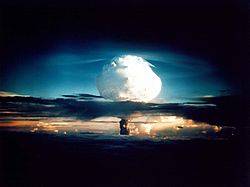
One of the most spectacular – and controversial – accomplishments of US technology has been the harnessing of nuclear energy. The concepts that led to the splitting of the atom were developed by the scientists of many countries, but the conversion of these ideas into the reality of nuclear fission was accomplished in the United States in the early 1940s, both by many Americans but also aided tremendously by the influx of European intellectuals fleeing the growing conflagration sparked by Adolf Hitler and Benito Mussolini in Europe.
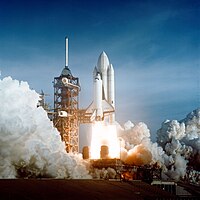
During these crucial years, a number of the most prominent European scientists, especially physicists, immigrated to the United States, where they would do much of their most important work; these included Hans Bethe, Albert Einstein, Enrico Fermi, Leó Szilárd, Edward Teller, Felix Bloch, Emilio Segrè, John von Neumann, and Eugene Wigner, among many, many others. American academics worked hard to find positions at laboratories and universities for their European colleagues.

After German physicists split a uranium nucleus in 1938, a number of scientists concluded that a nuclear chain reaction was feasible and possible. The Einstein–Szilárd letter to President Franklin D. Roosevelt warned that this breakthrough would permit the construction of “extremely powerful bombs.” This warning inspired an executive order towards the investigation of using uranium as a weapon, which later was superseded during World War II by the Manhattan Project the full Allied effort to be the first to build an atomic bomb. The project bore fruit when the first such bomb was exploded in New Mexico on July 16, 1945.
The development of the bomb and its use against Japan in August 1945 initiated the Atomic Age, a time of anxiety over weapons of mass destruction that has lasted through the Cold War and down to the anti-proliferation efforts of today. Even so, the Atomic Age has also been characterized by peaceful uses of nuclear power, as in the advances in nuclear power and nuclear medicine.

Along with the production of the atomic bomb, World War II also began an era known as “Big Science” with increased government patronage of scientific research. The advantage of a scientifically and technologically sophisticated country became all too apparent during wartime, and in the ideological Cold War to follow the importance of scientific strength in even peacetime applications became too much for the government to any more leave to philanthropy and private industry alone. This increased expenditure on scientific research and education propelled the United States to the forefront of the international scientific community—an amazing feat for a country which only a few decades before still had to send its most promising students to Europe for extensive scientific education.
The first US commercial nuclear power plant started operation in Illinois in 1956. At the time, the future for nuclear energy in the United States looked bright. But opponents criticized the safety of power plants and questioned whether safe disposal of nuclear waste could be assured. A 1979 accident at Three Mile Island in Pennsylvania turned many Americans against nuclear power. The cost of building a nuclear power plant escalated, and other, more economical sources of power began to look more appealing. During the 1970s and 1980s, plans for several nuclear plants were cancelled, and the future of nuclear power remains in a state of uncertainty in the United States.
Meanwhile, American scientists have been experimenting with other renewable energy, including solar power. Although solar power generation is still not economical in much of the United States, recent developments might make it more affordable.
Telecom and technology

For the past 80 years, the United States has been integral in fundamental advances in telecommunications and technology. For example, AT&T’s Bell Laboratories spearheaded the American technological revolution with a series of inventions including the first practical light emitted diode (LED), the transistor, the C programming language, and the Unix computer operating system.[26] SRI International and Xerox PARC in Silicon Valley helped give birth to the personal computer industry, while ARPA and NASA funded the development of the ARPANET and the Internet.[27]

Herman Hollerith was just a twenty-year-old engineer when he realized the need for a better way for the U.S. government to conduct their Census and then proceeded to develop electromechanical tabulators for that purpose. The net effect of the many changes from the 1880 census: the larger population, the data items to be collected, the Census Bureau headcount, the scheduled publications, and the use of Hollerith’s electromechanical tabulators, was to reduce the time required to process the census from eight years for the 1880 census to six years for the 1890 census.[28] That kick started The Tabulating Machine Company. By the 1960s, the company name had been changed to International Business Machines, and IBM dominated business computing.[29] IBM revolutionized the industry by bringing out the first comprehensive family of computers (the System/360). It caused many of their competitors to either merge or go bankrupt, leaving IBM in an even more dominant position.[30] IBM is known for its many inventions like the floppy disk, introduced in 1971, supermarket checkout products, and introduced in 1973, the IBM 3614 Consumer Transaction Facility, an early form of today’s Automatic Teller Machines.[31]
In 1983, the DynaTAC 8000x was the first commercially available handheld mobile phone. From 1983 to 2014, worldwide mobile phone subscriptions grew to over seven billion; enough to provide one for every person on Earth.[32]
The Space Age

Sojourner is 65 cm (2.13 ft) long. The MERs are 1.6 m (5.2 ft) long. Curiosity on the right is 3 m (9.8 ft) long.


During the Cold War, competition for superior missile capability led to the Space Race between the United States and Soviet Union.[33][34] American Robert Goddard was one of the first scientists to experiment with rocket propulsion systems. In his small laboratory in Worcester, Massachusetts, Goddard worked with liquid oxygen and gasoline to propel rockets into the atmosphere, and in 1926 successfully fired the world’s first liquid-fuel rocket which reached a height of 12.5 meters.[35] Over the next 10 years, Goddard’s rockets achieved modest altitudes of nearly two kilometers, and interest in rocketry increased in the United States, Britain, Germany, and the Soviet Union.[36]
As Allied forces advanced during World War II, both the American and Russian forces searched for top German scientists who could be claimed as spoils for their country. The American effort to bring home German rocket technology in Operation Paperclip, and the bringing of German rocket scientist Wernher von Braun (who would later sit at the head of a NASA center) stand out in particular.
Expendable rockets provided the means for launching artificial satellites, as well as crewed spacecraft. In 1957, the Soviet Union launched the first satellite, Sputnik 1, and the United States followed with Explorer 1 in 1958. The first human spaceflights were made in early 1961, first by Soviet cosmonaut Yuri Gagarin and then by American astronaut Alan Shepard.
From those first tentative steps, to the Apollo 11 landing on the Moon and the partially reusable Space Shuttle, the American space program brought forth a breathtaking display of applied science. Communications satellites transmit computer data, telephone calls, and radio and television broadcasts. Weather satellites furnish the data necessary to provide early warnings of severe storms. The United States also developed the Global Positioning System (GPS), the world’s pre-eminent satellite navigation system.[37] Interplanetary probes and space telescopes began a golden age of planetary science and advanced a wide variety of astronomical work.
On April 20, 2021, MOXIE produced oxygen from Martian atmospheric carbon dioxide using solid oxide electrolysis, the first experimental extraction of a natural resource from another planet for human use.[38] In 2023, the United States ranked 3rd in the Global Innovation Index.[39]
Medicine and health care


As in physics and chemistry, Americans have dominated the Nobel Prize for physiology or medicine since World War II. The private sector has been the focal point for biomedical research in the United States, and has played a key role in this achievement.
Maurice Hilleman, a well-known American virologist, is remembered for having developed more than 40 vaccines, thus creating an important record in the field of medicine. He was responsible for his contribution to the creation of vaccines against the Asian flu of 1957, which broke out in Guizhou, and the Hong Kong flu of 1968, contributing to the preparation and distribution of the vaccine doses that saved the world. He was responsible for the creation of vaccines against measles, mumps, hepatitis A, hepatitis B, chickenpox, Neisseria meningitidis, Streptococcus pneumoniae and Haemophilus influenzae. He was awarded the Distinguished Service Medal by the US Army for his important work.[1].
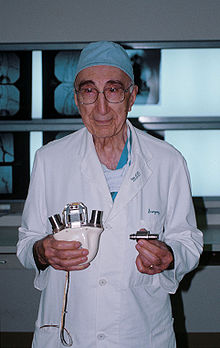
As of 2000, for-profit industry funded 57%, non-profit private organizations such as the Howard Hughes Medical Institute funded 7%, and the tax-funded National Institutes of Health (NIH) funded 36% of medical research in the United States.[40] However, by 2003, the NIH funded only 28% of medical research funding; funding by private industry increased 102% from 1994 to 2003.[41]
The NIH consists of 24 separate institutes in Bethesda, Maryland. The goal of NIH research is knowledge that helps prevent, detect, diagnose, and treat disease and disability. At any given time, grants from the NIH support the research of about 35,000 principal investigators. Five Nobel Prize-winners have made their prize-winning discoveries in NIH laboratories.
NIH research has helped make possible numerous medical achievements. For example, mortality from heart disease, the number-one killer in the United States, dropped 41 percent between 1971 and 1991. The death rate for strokes decreased by 59 percent during the same period. Between 1991 and 1995, the cancer death rate fell by nearly 3 percent, the first sustained decline since national record-keeping began in the 1930s. And today more than 70 percent of children who get cancer are cured.
With the help of the NIH, molecular genetics and genomics research have revolutionized biomedical science. In the 1980s and 1990s, researchers performed the first trial of gene therapy in humans and are now able to locate, identify, and describe the function of many genes in the human genome.
Research conducted by universities, hospitals, and corporations also contributes to improvement in diagnosis and treatment of disease. NIH funded the basic research on Acquired Immune Deficiency Syndrome (AIDS), for example, but many of the drugs used to treat the disease have emerged from the laboratories of the American pharmaceutical industry; those drugs are being tested in research centers across the country.
See also
- Science policy of the United States
- Biomedical research in the United States
- Technological and industrial history of the United States
- Timeline of United States inventions
- Timeline of United States discoveries
- National Inventors Hall of Fame
- United States Patent and Trademark Office
- NASA spinoff technologies
- Yankee ingenuity
References
- ^ “Guide to the Constitution”.
- ^ “A Brief History of U.S. Patent Law”.
- ^ “Lemelson-MIT Program”. Archived from the original on February 19, 2003.
- ^ “Thomas Jefferson, a Brief Biography – Thomas Jefferson’s Monticello”.
- ^ “Thomas Jefferson and the Lewis and Clark Expedition – Thomas Jefferson’s Monticello”.
- ^ a b c d e f g “American Spaces – Connecting YOU with U.S.”
- ^ “Tesla’s Biography”.
- ^ Angelo, Joseph A.. Nuclear Technology (Westport: Greenwood, 2004), 17
- ^ Isaacson, Walter. Einstein: His Life and His Universe (New York: Simon & Schuster, 2007), 407
- ^ Isaacson, Walter. Einstein: His Life and His Universe (New York: Simon & Schuster, 2007), 473
- ^ Teller, Edward. Memoirs: A Twentieth Century Journey in Science and Politics (Cambridge: Perseus, 2001), 546
- ^ Gimbel, John. “German Scientists, United States Denazification Policy, and the ‘Paperclip Conspiracy,’” The International History Review, Vol. 12, No. 3 (Aug., 1990): 448-449.
- ^ Hunt, Linda. Secret Agenda: The United States Government, Nazi Scientists, and Project Paperclip, 1945 to 1990 (New York: St.Martin’s Press, 1991).
- ^ Ward, Bob. Doctor Space (Annapolis: Naval Institute Press, 2005), 83
- ^ Kay, Alison J.. What If There’s Nothing Wrong? (BalboaPress November 27, 2012)
- ^ Dowty, Alan. Closed Borders: The Contemporary Assault on Freedom of Movement (Binghampton: Twentieth Century Fund, 1987.), 122.
- ^ National Research Council (U.S.). (1997). Maximizing U.S. Interests in Science and Technology Relations with Japan: Committee on Japan Framework Statement and Report of the Competitiveness Task Force. Washington, D.C.: National Academies Press.
- ^ Walker, William (1993). “National Innovation Systems: Britain”. In Nelson, Richard R. (ed.). National innovation systems : a comparative analysis. New York: Oxford University Press. pp. 61–4. ISBN 0195076176.
- ^ Ulrich Wengenroth (2000). “Science, Technology, and Industry in the 19th Century” (PDF). Munich Centre for the History of Science and Technology. Retrieved June 13, 2016.
{{cite journal}}: Cite journal requires|journal=(help) - ^ “Thomas Edison’s Most Famous Inventions”. Thomas A Edison Innovation Foundation. Archived from the original on March 16, 2016. Retrieved January 21, 2015.
- ^ Benedetti, François (December 17, 2003). “100 Years Ago, the Dream of Icarus Became Reality”. Fédération Aéronautique Internationale (FAI). Archived from the original on September 12, 2007. Retrieved August 15, 2007.
- ^ Fraser, Gordon (2012). The Quantum Exodus: Jewish Fugitives, the Atomic Bomb, and the Holocaust. New York: Oxford University Press. ISBN 978-0-19-959215-9.
- ^ Sawyer, Robert Keith (2012). Explaining Creativity: The Science of Human Innovation. Oxford University Press. p. 256. ISBN 978-0-19-973757-4.
- ^ Mowery, D. C., & Rosenberg, N. (1998). Paths of Innovation: Technological Change in 20th-Century America. Cambridge, UK: Cambridge University Press.
- ^ The Sources and Uses of U.S. Science Funding.
- ^ “AT&T Labs Fosters Innovative Technology – AT&T Labs”.
- ^ “012 ARPA History”.
- ^ Report of the Commissioner of Labor In Charge of The Eleventh Census to the Secretary of the Interior for the Fiscal Year Ending June 30, 1895 Washington, D.C., July 29 1895 Page 9: You may confidently look for the rapid reduction of the force of this office after the 1st of October, and the entire cessation of clerical work during the present calendar year. … The condition of the work of the Census Division and the condition of the final reports show clearly that the work of the Eleventh Census will be completed at least two years earlier than was the work of the Tenth Census. Carroll D. Wright Commissioner of Labor in Charge.
- ^ “The Future of the Internet—And How to Stop It » Chapter 1: Battle of the Boxes”. Archived from the original on April 2, 2014. Retrieved April 2, 2014.
- ^ “Computer History Museum – International Business Machines Corporation (IBM) – The Entire Concept of Computers Has Changed…IBM System/360”.
- ^ “IBM – Archives – History of IBM – 1970 – United States”. January 23, 2003.
- ^ “Mobile penetration”. July 9, 2010.
Almost 40 percent of the world’s population, 2.7 billion people, are online. The developing world is home to about 826 million female internet users and 980 million male internet users. The developed world is home to about 475 million female Internet users and 483 million male Internet users.
- ^ 10 Little Americans. Lulu.com. ISBN 978-0-615-14052-0. Retrieved September 15, 2014 – via Google Books.
- ^ “NASA’s Apollo technology has changed the history”. Sharon Gaudin. July 20, 2009. Retrieved September 15, 2014.
- ^ “Spaceline: History of Rocketry : Goddard”.
- ^ “American Spaces – Connecting YOU with U.S.”
- ^ Ngak, Chenda (July 4, 2012). “Made in the USA: American tech inventions”. CBS News.
- ^ Hecht, M.; Hoffman, J.; Rapp, D.; McClean, J.; SooHoo, J.; Schaefer, R.; Aboobaker, A.; Mellstrom, J.; Hartvigsen, J.; Meyen, F.; Hinterman, E. (January 6, 2021). “Mars Oxygen ISRU Experiment (MOXIE)”. Space Science Reviews. 217 (1): 9. Bibcode:2021SSRv..217….9H. doi:10.1007/s11214-020-00782-8. hdl:1721.1/131816.2. ISSN 1572-9672. S2CID 106398698.
- ^ WIPO. “Global Innovation Index 2023, 15th Edition”. www.wipo.int. doi:10.34667/tind.46596. Retrieved October 17, 2023.
- ^ The Benefits of Medical Research and the Role of the NIH.
- ^ Medical Research Spending Doubled Over Past Decade, Neil Osterweil, MedPage Today, September 20, 2005
